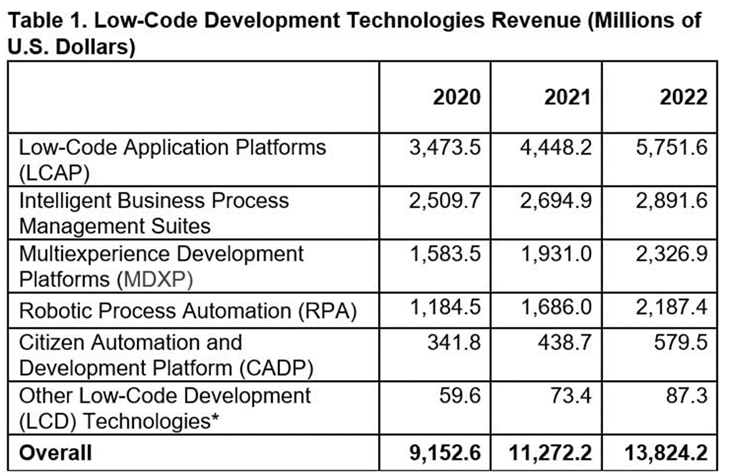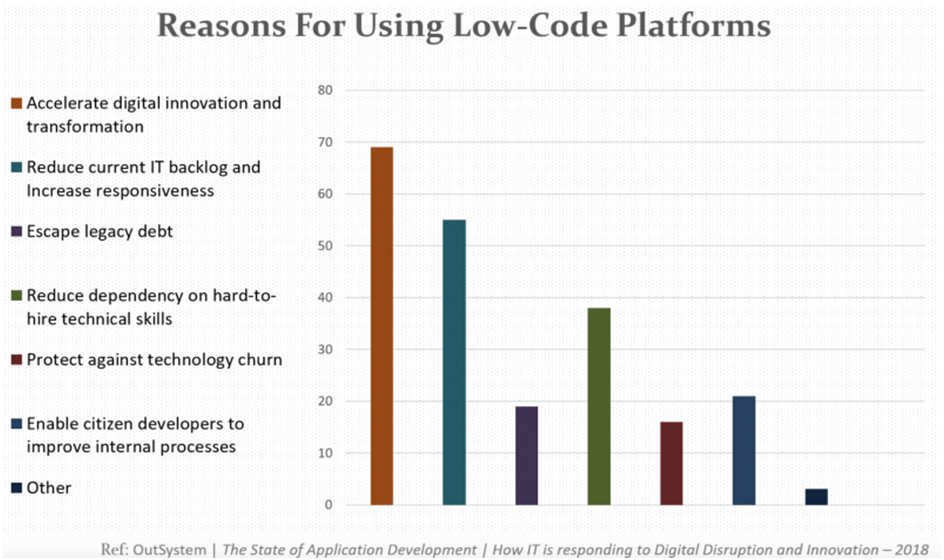No-Code or Low-Code is the Future of Automation! Is it True?
By :- Nav - Web Guru Awards Team

Organizations totally depend on their IT team to create codes or scripts necessary for the smooth running of all the operations. But sometimes inevitable issues occur, especially due to employee shortage that often leaves firms with dysfunctional processes. You can tackle these problems by using no- or low-code automation platforms.
Such platforms reduce dependencies on IT specialists and enable users to make customized applications easily. As a result, the idea of implementing these solutions is gaining acceptance rapidly in every sector. As per Gartner's predictions, the low-code development technologies industry grew by 23% in 2021.

Source
What is Low-Code?
Low-Code or no-code is one of the fastest-growing trends in software development. It takes coding out of the domain of IT engineers and puts it in the business user's hands. Low-Code refers to various tools that allow non-technical people to develop applications for their business.
This concept is not new and has been around for several years. But, it is going through a renewal due to the increased interest of many development firms. It requires fewer resources and time than the traditional coding process. So, it is perfect for small businesses. They don't have to spend a considerable amount on custom programming.
No-code or low-code automation platforms are programs that need little to no coding knowledge. Unlike traditional backend programming, it takes a more visual approach and offers a user-friendly drag-and-drop interface and predesigned workflow templates to customize workflows.
Features of No-Code or Low-Code
Low-code platforms automate the lengthy coding process, allowing programmers to focus on the significant project elements. These platforms have the following features and functionalities:
- Visual Design Tools: These are pre-built functions or components that allow you to drag and drop fields in the application. As a result, you do not have to do the coding.
- Business Rules: It enables processes and workflows with systems such as CRM or ERP. So, you can pull figures in real-time reports.
- Connectivity: Low-code platforms integrate with backend systems such as CRM or ERP.
- Business Process Automation: This feature lets developers integrate apps with business processes through APIs to access current systems and connect directly to them.
- Cloud Deployment: It allows applications to deploy in the cloud or produce environments where anyone can access them using the internet.
What to Code Using Low-Code Development Platforms?
You can create websites, mobile apps, and backend systems using low-code development platforms. They allow you to create apps by simply dragging and dropping components instead of writing code. Low-code development tends to be associated with rapid application development (RAD).
For example, consumer goods manufacturers could use low-code platforms to create a manufacturing dashboard to oversee the production lines.
Benefits of Low-Code Development

Source
The following are some benefits of choosing low-code development:
Faster Time-to-Market
No-code development platforms enable programmers to start instantly and create a functional prototype without a code from scratch. They can use pre-made and reusable templates to develop new apps at minimum time. As a result, it drastically reduces the time required for testing and launch.
Lowers Technical Debt
When the IT team gets overloaded with numerous projects for supporting the business, a backlog can feel never-ending. However, if non-technical employees can create the software easily as per the requirements, the IT specialists will get a breather.
In addition, Low-code software platforms help organizations reduce waste, shorten development, and speed up the deployment process. As a result, it eliminates technical debt.
Reduces Costs
Low-code development enables IT heads to get what they expected. They can create quality enterprise-grade software in a minimum time than the traditional development approach. In addition, low-code offers organizations a more accessible and cheaper way to make workflows and business processes while customizing them.
Enterprise-Wide Efficiencies
Programmers can introduce unique functionalities and features into their software without spending much time by using low-code software development tools. Moreover, it is easier for developers to manage the data model, user interface, definitions, and business rules. Finally, it means that even programmers with less experience can build software quickly.
As a result, it reduces the dependency on expensive skilled people. In addition, low-code tools eliminate the requirement for the IT team constantly to update the infrastructure, frameworks, and underlying technology.
Innovation Support
Low-code consists of user-centric techniques like design thinking. It enables developers to test an idea by launching an MVP (minimum viable product) in the industry before the launch. In addition, it gathers market performance data and customer feedback without spending much effort and time. Thus, enterprises can translate ideas to action fastly.
What is the Future of Low-Code Platforms?
The low-code area is experiencing rapid growth thanks to the many advantages. However, the final decision to use a low code entirely depends on the business's needs and objectives.
From low code apps to built-in Artificial Intelligence, analytics, Microsoft Power Platform helps customers with a set of low code tools. It ensures that all customers and employees have the tools required to solve issues at scale across their enterprises.
Conclusion
No-code or low-code technology allows organizations of all sizes to overcome the shortage of developers regardless of available resources. It will create a more inclusive and diverse market. The primary key to success is picking the proper tool and moving forward with a strong plan.
Recent Topics
-
 WordPress.com Launches 100-Year Web Hosting Plan
WordPress.com Launches 100-Year Web Hosting PlanWordPress, the platform that helps people create websites, now offers something rare. It has taken a bold leap into the future with its 100-year web hosting plan. ...
Read MoreBy :- Laura Davidson
-
 5 Best AI Web Design Tools You Can Try
5 Best AI Web Design Tools You Can TryWhy bother with all the effort of creating websites manually when we have amazing AI tools? In fact, using these tools has become one of the most-practiced ...
Read MoreBy :- Tiana K
-
 Role of Animation and Micro-Interactions in User Experience
Role of Animation and Micro-Interactions in User ExperienceIn today's world, almost every brand wants to create a user-friendly interface for its customers. The main aim behind this is to increase customer base and revenue. Now, when it comes...
Read MoreBy :- Laura Davidson
-
 Web Design Trends to Watch Out for in 2024
Web Design Trends to Watch Out for in 2024Web design is a constant-evolving technology landscape. As a web designer, staying tuned with web design trends and keeping your designs up-to-date is important. These trends will affect ...
Read MoreBy :- Esther McGuinness
-
 The Power of Storytelling in Web Design Engaging Users with a Narrative
The Power of Storytelling in Web Design Engaging Users with a NarrativeStories never fail to engage listeners. That’s why web designers are leveraging the art of storytelling in their designs. In web designing, storytelling goes beyond merely usin...
Read MoreBy :- Navkiran Dhaliwal
-
 WordPress Releases Version 6.3 ?“Lionel”
WordPress Releases Version 6.3 ?“Lionel”WordPress 6.3 “Lionel” is out! Now, you’ll be able to create more beautiful and compelling websi...
Read MoreBy :- Tiana K
